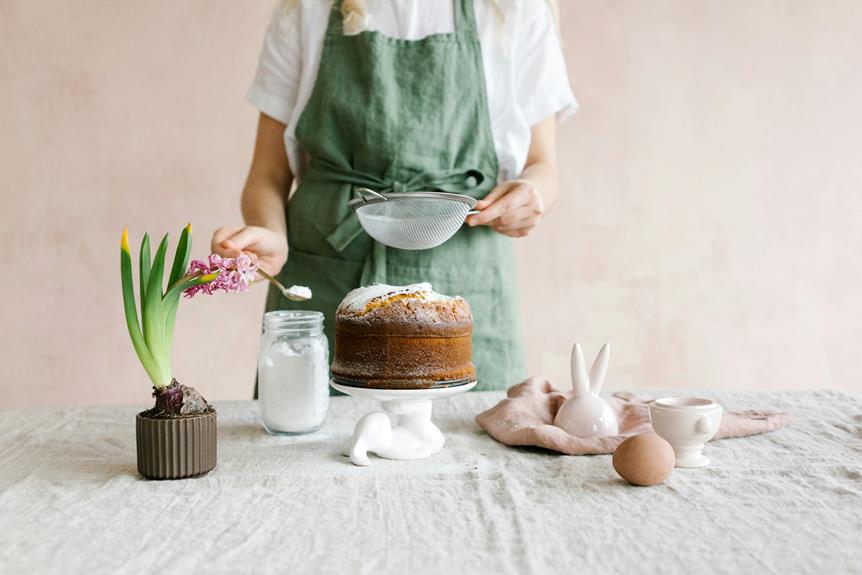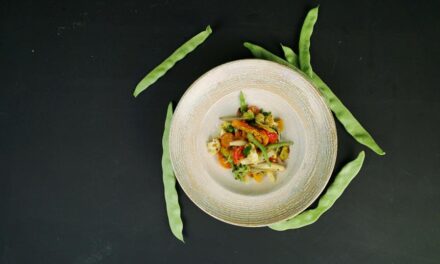When browsing flour options in Australia, you'll likely come across cake flour, a finely milled flour made from soft wheat that's perfect for baking delicate treats like cakes and pastries with a tender texture. Its low protein content of 6-9% promotes minimal gluten formation, while its bleaching process enhances baking properties. Cake flour is ideal for light-textured baked goods like sponge cakes, muffins, and cupcakes. It's available in major grocery stores like Coles and Woolworths, and you can even make your own at home. Discover how cake flour can elevate your baking and learn more about its unique characteristics.
What Is Cake Flour
Walking into a baking aisle, you might've stumbled upon the term 'cake flour' and wondered what it's all about. Cake flour is a finely milled flour made from soft wheat, particularly popular in baking delicate treats like cakes and pastries. Although its history isn't extensively documented, it's known that cake flour has been a staple in many professional bakeries for years, prized for its tenderizing properties.
In terms of cake flour varieties, there isn't a wide range available in Australia. However, you can find it in specialty baking shops or online. The Australian version typically has a low protein content of 6-9% and undergoes a bleaching process to enhance its baking properties. You might not find cake flour in standard grocery stores, but it's worth seeking out for its unique qualities. If you can't find it, you can also make a homemade substitute by mixing all-purpose flour with cornstarch, which mimics cake flour's lower gluten content.
Properties and Benefits of Cake Flour
As you explore the world of cake flour, you'll notice its unique properties make it ideal for baking. With a low protein content of 6-8%, cake flour has a significant impact on gluten formation, resulting in a tender and delicate texture. By understanding these properties, you can reveal the benefits of using cake flour, including enhanced texture and a softer crumb structure in your baked goods.
Cake Flour Properties
When it comes to producing tender and delicate baked goods, the properties of cake flour make it an ideal choice. You may be wondering what makes cake flour so special. The answer lies in its origins – it's finely milled from soft wheat with a lower protein content, typically between 6-8%. This lower protein content is perfect for cake flour uses like baking cakes, muffins, and pastries.
The unique properties of cake flour result in a softer crumb structure, contributing to lighter and fluffier baked goods. Additionally, cake flour absorbs more liquid compared to all-purpose flour, helping to retain moisture in baked products and prolonging their freshness. The bleaching process that cake flour often undergoes also enhances its baking qualities by improving its ability to absorb sugar and water, resulting in better rise and volume.
These properties make cake flour a staple in many bakeries, especially when it comes to producing delicate treats. While it's not commonly found in Australia, you can still source it from specialty baking stores or make your own at home by mixing plain flour with cornstarch.
Gluten Formation Impact
The unique properties of cake flour make it a go-to choice for bakers seeking tender and delicate textures. One of the key benefits of cake flour is its low protein content, which results in minimal gluten formation. This is especially important for those with gluten sensitivity, as it can help reduce the gluten impact in their baked goods.
| Benefits of Low Gluten Formation | Description |
|---|---|
| Softer Crumb Structure | Allows for a lighter texture in baked goods, ideal for cakes and pastries |
| Reduced Toughness | Prevents the development of toughness in baked goods, maintaining their softness |
| Increased Moisture | Helps maintain moisture in baked goods, contributing to a fresher taste and longer shelf life |
When you choose cake flour, you're not only reducing the gluten impact, but also creating a more tender and delicate texture in your baked goods. This is because the lower gluten formation allows for a softer crumb structure and reduced toughness. By using cake flour, you can create delicious and tender baked goods that are perfect for those with gluten sensitivity.
Texture Enhancement Benefits
You've probably noticed that cake flour is a staple in many bakers' pantries, and for good reason – its unique properties make it a game-changer for achieving tender and delicate textures in baked goods. One of the key benefits of using cake flour is its ability to create a softer crumb structure, thanks to its finer milling process. This results in a more delicate texture that's perfect for light and airy desserts like chiffon and sponge cakes.
When you use cake flour in your baking techniques, you'll also notice that it absorbs more liquid than other flours, helping to keep your baked items moist and extending their freshness. Plus, the bleaching process that cake flour undergoes improves its ability to retain water and sugar, leading to better rise and volume in your baked products. Whether you're using a popular cake flour brand or experimenting with different recipes, incorporating cake flour into your baking routine can help take your texture to the next level. By choosing the right cake flour for your recipes, you'll be able to achieve a more consistent and desirable texture that will impress anyone who tries your creations.
Uses of Cake Flour in Baking
When you're working with cake flour in your baking, you'll likely use it to make light-textured cakes that rise beautifully and have a tender crumb. You'll also find it's perfect for making delicate pastries, muffins, and cupcakes, as it helps retain moisture and keeps baked goods fresh for longer. By incorporating cake flour into your recipes, you'll notice a difference in the texture and overall quality of your baked goods, making it a great choice for a variety of sweet treats.
Uses in Cake Recipes
If you're looking to create tender, delicate baked goods that are sure to impress, cake flour is your best bet. Despite the many cake flour myths surrounding its use, it's actually a versatile ingredient that can help you achieve professional results in your baking. When it comes to cake recipes, cake flour is the go-to choice for many bakers due to its low protein content, which results in a tender crumb and delicate texture.
If you're looking to make a classic sponge cake or a decadent chiffon cake, cake flour is a must-have ingredient. It's also perfect for muffins and cupcakes, where a tender crumb is essential for ideal texture and taste. Cake flour absorbs more liquid than other types of flour, which helps keep your cakes moist and fresh for longer. By incorporating cake flour into your cake recipes, you can create delicious baked goods that will impress even the most discerning palates. So, the next time you're baking a cake, consider using cake flour to take your baking to the next level.
Benefits in Pastry Making
In the world of pastry making, having the right ingredients can make all the difference. You'll find that cake flour benefits your baked goods in many ways, making it a staple in your pantry. With its low protein content (6-8%), it's perfect for making tender and delicate pastries. The finer grind of cake flour helps you achieve a smooth batter, especially beneficial for delicate recipes like chiffon cakes and sponge cakes.
When using cake flour in pastries, it absorbs more liquid, keeping your final product moist and extending its freshness. Its unique properties also enhance the rise and volume in baked pastries, making it ideal for achieving airy textures in muffins and cupcakes. What's more, cake flour minimizes toughness in pastry dough, resulting in flaky and tender pastries like scones and biscuits. This is due to its lower gluten formation, which allows you to create a variety of delicious pastries with ease. By incorporating cake flour into your pastry making, you'll experience the benefits firsthand and take your baked goods to the next level.
Enhancing Baked Goods Texture
Beneath the surface of every great baked good lies a well-crafted texture that's sure to delight the senses. When it comes to achieving the perfect cake texture, you can't go wrong with cake flour. With its lower protein content of 6-8%, cake flour is ideal for light-textured baked goods like cakes, muffins, and pastries.
In baking science, the type of flour used can greatly impact the final product's texture. Here are some ways cake flour can enhance your baked goods:
- *Better moisture retention*: The finer grind of cake flour allows for better absorption of liquids and sugars, resulting in a moister cake.
- *Higher rise and fluffiness*: Cake flour's lower gluten-forming ability makes it perfect for chiffon and sponge cakes.
- *Softer texture and greater volume*: The bleaching process that cake flour undergoes improves its baking qualities, resulting in a softer texture and greater volume.
- *Lighter and more aerated batters*: Sifting cake flour before use can further enhance the lightness and aeration of your batters and doughs, ensuring superior baking results.
Cake Flour Substitutions and Alternatives
What's the best way to replicate cake flour in a pinch, especially when it's nowhere to be found in your local Australian supermarket? If you can't find cake flour, don't stress – there are several alternatives and substitutions you can use. For instance, you can make your own cake flour at home by using 1 cup of plain flour minus 2 tablespoons, then adding 2 tablespoons of cornstarch. Sifting the mixture multiple times will give you the best results.
If you're looking for a store-bought alternative, pastry flour with a protein content of 8-10% is a suitable option. Keep in mind that it'll give your baked goods a slightly denser texture, but they'll still be tender. If you're after a healthier option, whole wheat pastry flour is a good choice, though it may make your cakes denser. If you're looking for cake flour types or specific cake flour brands, you might not find them in every Australian supermarket, but you can try substituting with these alternatives to achieve similar results. Specialty gluten-free flours, like rice flour or a gluten-free flour blend, are also options for gluten-free baking.
Where to Buy Cake Flour in Australia
If you've decided you don't want to make your own cake flour at home, you're probably wondering where to find it in Australian stores. The good news is that cake flour is widely available in major grocery chains across the country.
Here are some popular places to buy cake flour in Australia:
- Major grocery chains: Coles and Woolworths typically stock cake flour, with brands like Lighthouse offering it for around AUD 3.65/kg.
- Aldi: This discount supermarket also carries a variety of flours, including gluten-free options that may include cake flour.
- Specialty baking stores: If you're looking for a specific cake flour brand, try visiting a specialty baking store or a local health food shop.
- Online retailers: Online shopping is another convenient option for buying cake flour, often with home delivery services available.
How to Make Cake Flour at Home
If you can't find cake flour or prefer a DIY approach, you can easily make it at home. You'll need to start with plain flour and mix it with another ingredient to mimic the lower protein content of cake flour. You can use cornstarch or other alternatives like arrowroot powder to create a homemade cake flour substitute.
Using Cornstarch Method
To make cake flour at home, you'll start with a simple substitution that can make a big difference in your baked goods. This is especially useful if you're trying to replicate specific cake flour types, like the ones used in Australian recipes. Since cake flour usage is common in delicate baked goods, it's worth understanding how to make it at home.
To make cake flour using the cornstarch method, follow these steps:
- Start with 1 cup of all-purpose flour and remove 2 tablespoons from it.
- Replace the removed flour with 2 tablespoons of cornstarch to mimic the lower protein content of cake flour.
- Sift the mixture 5-6 times to guarantee proper blending of the cornstarch and flour for a lighter texture.
- Use this homemade cake flour alternative immediately or store it in an airtight container to maintain freshness.
Keep in mind that this homemade version won't have the same fine milling as store-bought cake flour, but it can still yield good results in baking. By making cake flour at home, you'll be able to experiment with different cake flour types and usage in your favorite recipes.
Substituting With Arrowroot
After making cake flour using the cornstarch method, you might want to experiment with other alternatives, and substituting with arrowroot is another great option. To do this, simply remove 2 tablespoons of plain flour from 1 cup and replace it with 2 tablespoons of arrowroot powder. Then, sift the mixture thoroughly to guarantee even distribution. For an even finer consistency, sift the mixture multiple times – 5-6 times should do the trick.
Using arrowroot powder can enhance the texture of your baked goods, providing a slightly lighter result compared to using cornstarch. This makes it a suitable alternative for cake flour. One of the arrowroot benefits is that it's gluten-free, making this homemade substitute perfect for gluten-free baking. This is particularly useful for those with gluten intolerance, as long as you're using it in recipes that accommodate such dietary needs. Keep in mind that homemade cake flour made with arrowroot may not perfectly mimic the unique properties of true cake flour, but it can still yield good results in baking.
Homemade Cake Flour
Making homemade cake flour is easier than you think. If you've fallen victim to cake flour misconceptions, thinking it's impossible to replicate at home, you're in luck. With a few simple steps, you can create a suitable alternative to store-bought cake flour.
To start, you'll need 1 cup of plain flour. Remove 2 tablespoons and replace them with 2 tablespoons of cornstarch. Here are some key tips to keep in mind:
- *Sift thoroughly* 5-6 times to guarantee proper blending and a finer texture.
- *Use immediately* after preparation to secure ideal results in baking.
- *Don't overdo it* – homemade cake flour is best used in moderation, as it can produce slightly denser baked goods.
- Don't expect perfection- while this DIY method works well, it might not replicate the exact properties of commercially milled cake flour.
Cake Flour Vs Other Types of Flour
When it comes to baking, you've likely noticed that there are various types of flour available, each with its own unique characteristics and purposes. Cake flour, with its distinct characteristics and applications, is one of them. So, how does it compare to other types of flour?
| Flour Type | Description |
|---|---|
| Cake Flour | Tender crumb, ideal for cakes and pastries |
| Plain Flour | Higher protein, versatile for various baked goods |
| Self-Raising Flour | Contains added leavening agents |
| Whole Wheat Flour | Rich in nutrients, produces denser baked goods |
Cake flour, with its low protein content and fine texture, is perfect for delicate baked goods that require a tender crumb. Its ability to absorb liquids and sugars makes it ideal for moist and fluffy cakes. However, it's not as versatile as plain flour, which can be used for a variety of baked goods. Unlike self-raising flour, cake flour requires additional leavening agents to achieve the desired rise. And, unlike whole wheat flour, cake flour is better suited for recipes that require lightness and tenderness.
Gluten Content in Cake Flour
You've got a good grasp of how cake flour compares to other types of flour, so let's take a closer look at what makes it perfect for delicate baked goods – its gluten content. Cake flour typically has a gluten content of around 6-8%, considerably lower than that of plain flour, which ranges from 9-12%. This lower gluten content is essential for producing tender and delicate baked goods.
Here's how the gluten content in cake flour affects its applications and nutrition:
- Tender crumb structure: The reduced gluten allows for a softer crumb structure in cakes, resulting in lighter and fluffier textures ideal for recipes like chiffon and sponge cakes.
- Less chewy texture: While cake flour is not gluten-free, its lower gluten content serves to create a less chewy and more airy finish in baked items compared to higher-protein flours.
- Delicate flavors: The lower gluten content in cake flour allows delicate flavors to shine through, making it perfect for cake flour applications that require subtle flavors.
- Nutritional benefits: The lower gluten content in cake flour also provides some nutritional benefits, as it can be easier to digest than higher-protein flours, making it a good option for cake flour nutrition.
Storing and Handling Cake Flour
Proper storage and handling of cake flour can greatly impact its performance and shelf life. When it comes to storing cake flour, it's crucial to keep it in a cool, dry place in an airtight container to prevent moisture absorption and maintain its quality.
| Storage Method | Storage Location | Shelf Life |
|---|---|---|
| Airtight container | Cool, dry place | 6-12 months |
| Airtight container | Refrigerator | Longer shelf life |
| Paper bag | Cool, dry place | Not recommended |
| Airtight container | Room temperature | 3-6 months |
To guarantee proper handling of cake flour, always sift it before use to aerate the flour and help achieve a lighter texture in baked goods. Measure the cake flour accurately by spooning it into a measuring cup and leveling it off with a straight edge. This will prevent using too much flour in recipes. If you've stored cake flour for an extended period, check for any off-smells or discoloration before using it in baking. By following these simple tips for cake flour storage and handling, you can enjoy better-baked goods and extend the shelf life of your flour.
Recipes Using Cake Flour
In the world of baking, cake flour is a versatile ingredient that helps create a range of mouthwatering treats. You can use it to make delicate baked goods like chiffon cakes, muffins, and pancakes, where a tender, light texture is desired. When it comes to cake flour recipes, the possibilities are endless. Here are some popular options to try:
- Layered Choc-Caramel Chokito Cake: This show-stopping dessert is perfect for special occasions, and cake flour helps it rise to new heights.
- Pina Colada Cake: With its tropical flavors and airy texture, this cake is a great way to showcase the benefits of using cake flour.
- Sticky Date and Chocolate Tart with Butterscotch Sauce: This sweet treat is a masterclass in baking techniques, and cake flour plays a key role in its success.
- Sponge Cake: This classic dessert is a great way to practice your baking skills, and cake flour is essential for achieving its signature light and fluffy texture.
When working with cake flour, remember to use it in recipes that call for it, as it can make a big difference in the final result.
Frequently Asked Questions
What Is the Substitute for Cake Flour in Australia?
If you're looking for a cake flour substitute, you can mix 1 cup of plain flour with 2 tablespoons of cornstarch for cake flour uses in your recipes, achieving similar results in Australian cake flour recipes.
Is Cake Flour Plain Flour or Self-Raising Flour?
When it comes to cake flour, you're probably wondering if it's just plain flour or self-raising flour. The answer's no, it's distinct – with lower protein content and finer milling, it's perfect for delicate baked goods like cakes and pastries.
What Can I Use Instead of Cake Flour?
You can swap cake flour with pastry flour in recipes for a similar texture, or make a substitute by mixing all-purpose flour with cornstarch for a lighter result in your cake flour recipes.
Is Cake Flour the Same as Bakers Flour?
You might think cake flour is the same as baker's flour, but it's not. Cake flour has lower protein content, finely milled for tender cakes, and is ideal for delicate cake flour recipes with precise characteristics.
Conclusion
Now that you know everything about cake flour, you're all set to bake like a pro in Australia. With its low protein content and fine texture, cake flour is perfect for delicate treats like cakes, cupcakes, and pastries. Experiment with different recipes and substitutions to find your perfect blend. Whether you're a seasoned baker or just starting out, cake flour is a must-have in your pantry for creating tender and delicious baked goods.










